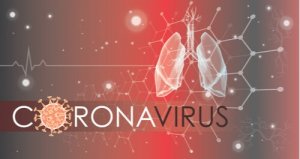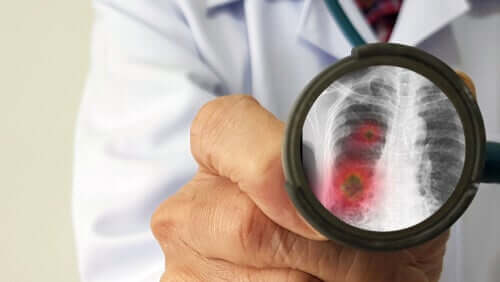How Coronavirus Infects Cells in the Lungs


Written and verified by the doctor Leonardo Biolatto
The information compiled up to this moment indicates that the most visible effect of the spread of coronavirus is an infection in the pulmonary cells. Although COVID-19 appeared just three months ago, there are several scientific studies that have explained aspects of the virus that’s causing illness. In the following article, we’ll talk about how coronavirus infects the cells inside the lungs.
Once inside a recently infected body, the droplets travel quickly to the back of the nasal passages and mucous membrane of the throat. Then, it produces a sort of “latch” between the virus and the cells of the receptor. Then, SARS-CoV-2 begins the infectious journey that causes damage to the entire body.
The virus latches on
Coronaviruses are surrounded by proteins in the shape of barbs. These proteins latch onto the cell membranes that it finds and invades them with genetic material. The effect of this is that the body itself begins to help the virus multiply and impedes the immune system from acting as it should.
In this way, copies of the virus appear, and then more copies, and so on. Each cell bursts and then releases viral particles that infect the neighboring cells. Little by little, the virus advances until it reaches the throat and then the bronchial tubes.
When SARS-CoV-2–or coronavirus–reaches the lungs, the pulmonary mucous membranes swell. When this occurs, the alveoli, which are small sacks of air, can become damaged. The swelling forces the alveoli to work more arduously in order to bring oxygen to the blood and expel carbon dioxide.
The swelling, along with damage to the flow of oxygen, can cause the lungs to fill with fluid, pus, and dead cells. This can produce an infection: pneumonia. At the same time, pneumonia can eventually lead to acute respiratory syndrome. At this point, patients can only breathe with the help of a respirator.

Continue reading: Is it Coronavirus, the Flu, or Allergies?
How coronavirus infects cells of the lungs
A study published in the journal Intensive Care Med managed to discover the process through which coronavirus infects the cells of the lungs in more detail. In order to conduct the study, researchers utilized a computer model.
According to their conclusions, the virus can attach to pulmonary cells thanks to the “barbs” they possess. These pointy proteins are very similar to a receptor—ACE2, which is also a protein–present in the cells of the human lung. This similarity makes it the virus “the perfect match”, so to say.
Scientists compare this affinity with a lock and key. This also explains the reason why this illness is so contagious. The researchers tell us that the virus better recognizes this receptor in the pulmonary cells and that this is why it spreads so easily. Given the aforementioned metaphor, it’s as if the lock attracts the key and vice versa.

Discover more: Can Food Be Contaminated by Coronavirus?
Damage to the lungs
Many ask why coronavirus infects cells in the lungs in particular. An initial response is that these organs are especially vulnerable to any type of inhaled virus. However, the research by Intensive Care Med points out that there are also biological factors at work.
The researchers specified that 82% of the cells that serve as “locks” for this virus’s “keys” are located in the pulmonary alveoli. Therefore, these pulmonary cells make viral invasion much easier. Those are the cells that SARS-CoV-2 can best latch onto.
However, the study also points out that these pulmonary cells are not the only ones that “fit” coronavirus. There are other similar cells in our bodies which are in the heart, liver, intestines, and endothelium. The scientists believe that the intestine, in particular, can be an important point of entry for coronavirus.
This data supports the hypothesis that the pandemic began due to the consumption of certain foods in the Wuhan market. If they manage to prove this hypothesis, the discovery will be of great importance. It will provide evidence that there is another means of contagion and be very relevant in the containment of this problem.
What’s the contribution of these discoveries?
Since we don’t have an abundance of answers regarding this new problem and pandemic, any scientific advancement is important. Research groups around the world are sharing their findings, practically in real-time, in order to advance more quickly. Understanding how coronavirus infects cells in the lungs is a tool that helps doctors know how to treat the complications of coronavirus.
All cited sources were thoroughly reviewed by our team to ensure their quality, reliability, currency, and validity. The bibliography of this article was considered reliable and of academic or scientific accuracy.
- Calvo, C., López-Hortelano, M. G., de Carlos Vicente, J. C., Martínez, J. L. V., de trabajo de la Asociación, G., Ramos, J. T., … & Fumadó, V. (2020, March). Recomendaciones sobre el manejo clínico de la infección por el «nuevo coronavirus» SARS-CoV2. Grupo de trabajo de la Asociación Española de Pediatría (AEP). In Anales de Pediatría. Elsevier Doyma.
- Herrera, Diego, and David Gaus. “Covid 19 evidencia.” Práctica Familiar Rural 5.1 (2020).
- Santo Domingo, D. N. “Protocolo para el diagnostico y tratamiento del coronavirus (COVID-19).” (2020).
This text is provided for informational purposes only and does not replace consultation with a professional. If in doubt, consult your specialist.








